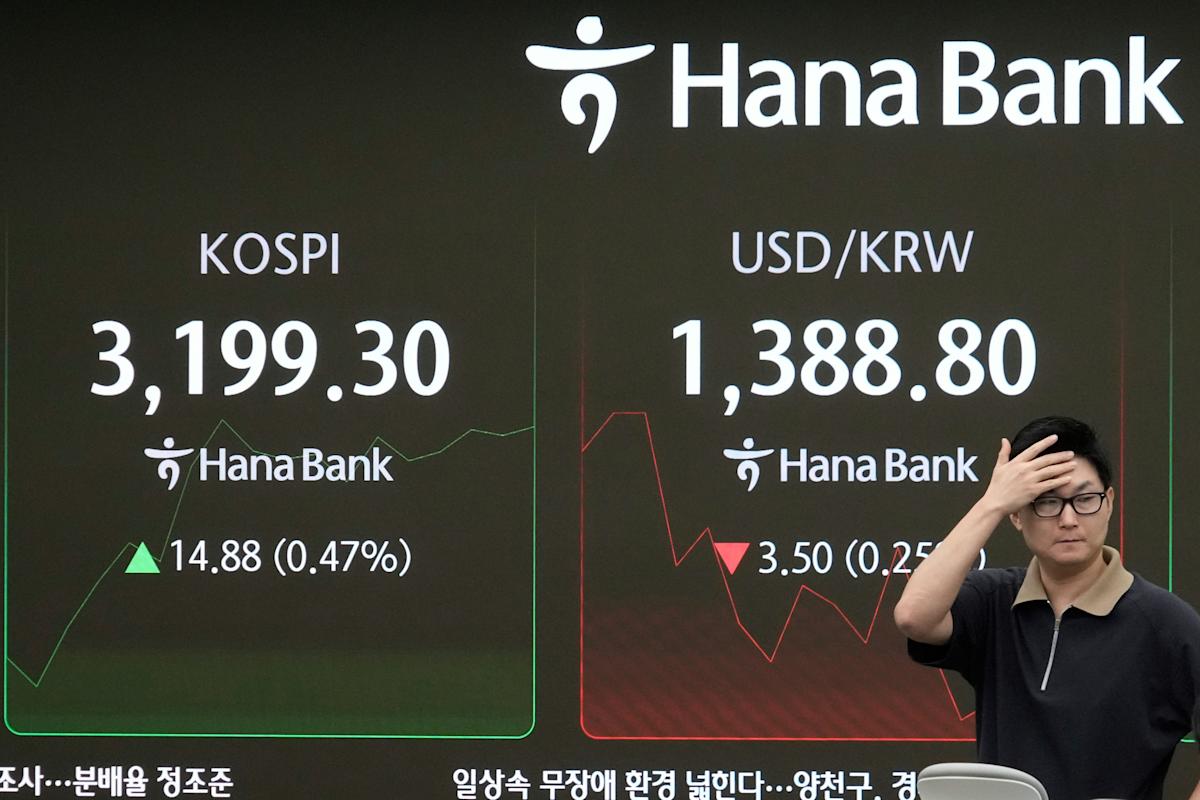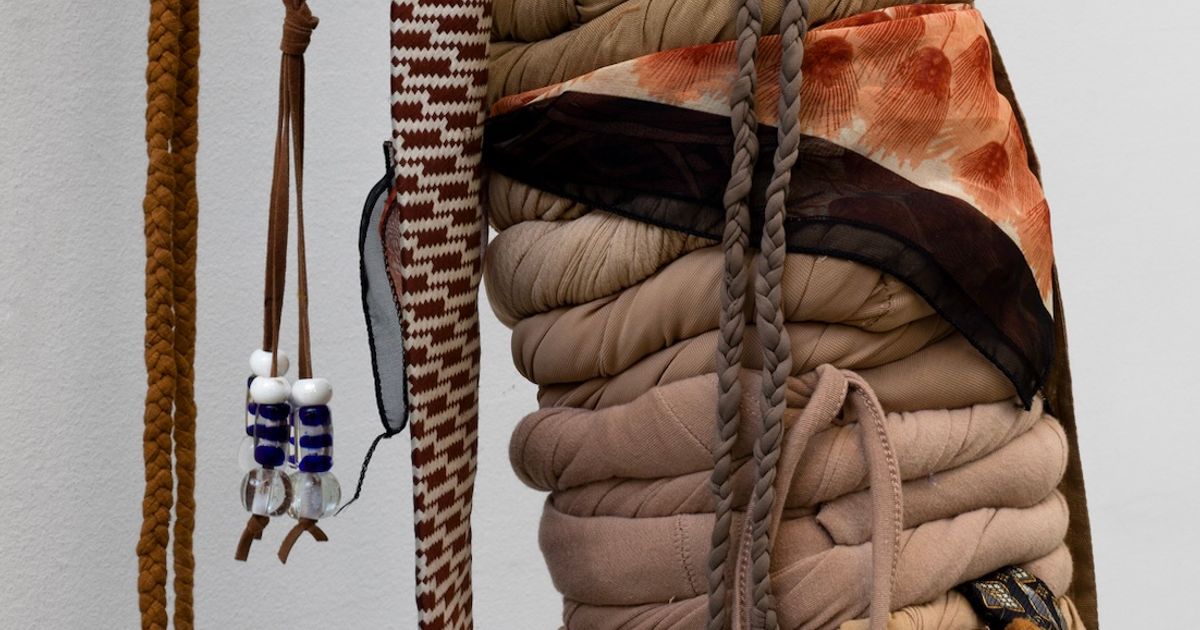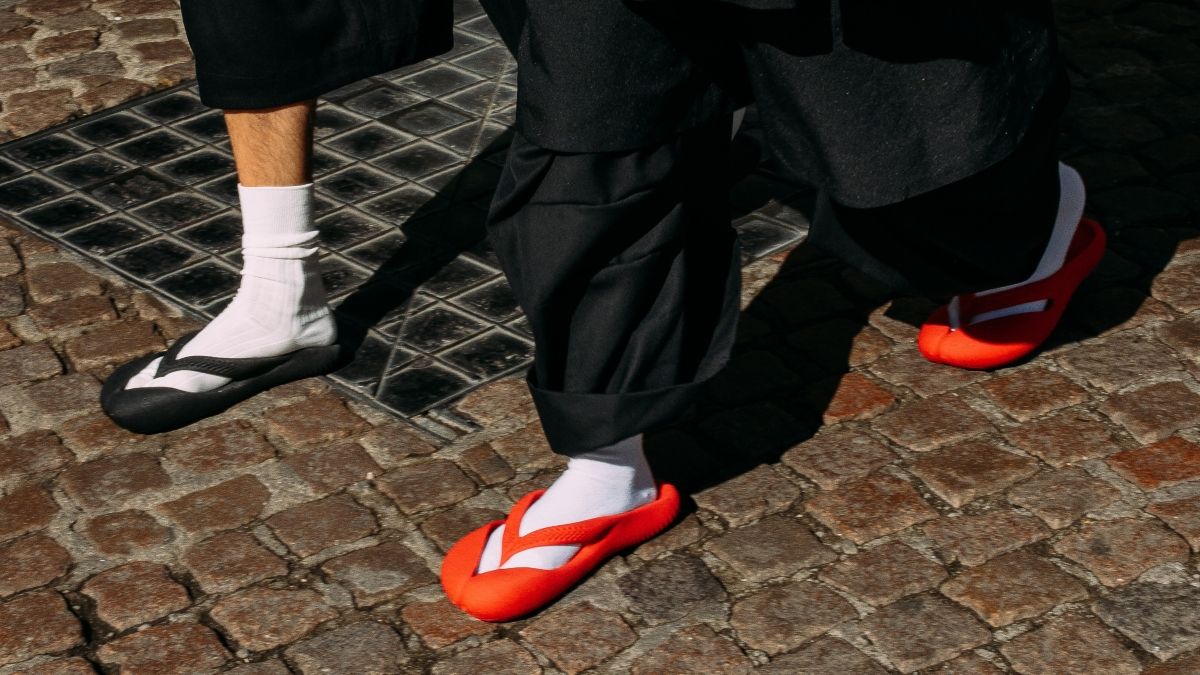- 46 dead, millions displaced as Chenab, Sutlej floods rise in Punjab samaa tv
- Floods kill 30 and submerge 1,400 villages in Indian state BBC
- Over 200,000 people relocated from flood-affected areas in Punjab: Rescue 1122 Dawn
- Floods in Pakistan: Agri, livestock officials mobilised for relief efforts Business Recorder
- Flood-hit Punjab braces for further strain from heavy rains The Nation (Pakistan )
Author: admin
-
46 dead, millions displaced as Chenab, Sutlej floods rise in Punjab – samaa tv
-

Making Their Mark: Works from the Shah Garg Collection – Announcements
A celebration of the creativity and innovation of an intergenerational, international group of women artists, many of whom are featured in St. Louis for the first time.
In the Kemper Art Museum’s largest seasonal exhibition to date, Making Their Mark: Works from the Shah Garg Collection highlights more than eighty works created by pioneering women artists in the last eight decades, including Andrea Bowers, Suzanne Jackson, Julie Mehretu, Howardena Pindell, Joan Mitchell, Lorna Simpson, Jaune Quick-to-See Smith, Sarah Sze, Kay WalkingStick, and Mary Weatherford, among many others. Featuring a wide spectrum of artworks—including painting, sculpture, installation, textile, beadwork, and ceramics—the exhibition emphasizes dialogues between artists who have circumvented and broken conventions in art-making by embracing craft techniques, new technologies, conceptual inquiries, inventive methods, and uncommon materials.
Making Their Mark is organized into six sections that illustrate key thematic threads: Gestural Abstraction, Painting and Technology, Craft Is Art, Of Selves and Spirits, Disobedient Bodies, and Luminous Abstraction. Each section juxtaposes works by emerging artists with the pathbreaking contributions of their predecessors, demonstrating how earlier generations anticipated current discussions around abstraction and representation, identity and power, and hybridity and performativity.
The exhibition envisions art history as an interconnected web of influences and affinities between artists who subvert traditional narratives and hierarchies established within a historically patriarchal field. Many of the works on view question rigid and gendered distinctions between art and craft, eroding arbitrary and increasingly obsolete categories and value systems that many women artists have long challenged.
Previously organized for venues in both New York and California, Making Their Mark will be transformed for its St. Louis presentation, enabled by the breadth and depth of the Shah Garg Collection. At the Kemper Art Museum, Sabine Eckmann, William T. Kemper Director and Chief Curator, has emphasized connections with artists who are currently represented in the Museum’s renowned permanent collection, such as Charline von Heyl, Amy Sillman, and Rose B. Simpson. St. Louis audiences will also have the opportunity to view works by a number of important artists for the first time, including the paintings of Laura Owens and Jacqueline Humphries. Other notable highlights will be the side-by-side presentation of works by Elizabeth Talford Scott and Joyce Scott, a mother and daughter. Through these unique juxtapositions, Making Their Mark enables viewers to expand their understandings of abstraction and reconceive of the expansive histories of art-making.
The exhibition is organized by the Shah Garg Foundation and its visionary founder, Komal Shah, a leader in the support and amplification of women’s voices in the arts.
The exhibition is curated by Cecilia Alemani, Donald R. Mullen Jr. Director and Chief Curator of High Line Art, and Sabine Eckmann, William T. Kemper Director and Chief Curator at the Kemper Art Museum.
Making Their Mark: Art by Women in the Shah Garg Collection (edited by Mark Godfrey and Katy Siegel), a richly illustrated volume on the collection, will be available for purchase in the Museum Shop.
Support
Making Their Mark: Works from the Shah Garg Collection is made possible through the lead support of the Shah Garg Foundation and the leadership support of the William T. Kemper Foundation. All exhibitions at the Kemper Art Museum are supported by members of the Director’s Circle, with major annual support provided by Emily and Teddy Greenspan and additional generous annual support from Deborah Beckmann and Jacob Kotzubei, Michael Forman and Jennifer Rice, Julie Kemper Foyer, Joanne Gold and Andrew Stern, David and Dorothy Kemper, Ron and Pamela Mass, and Kim and Bruce Olson. Further support is provided by the Hortense Lewin Art Fund, the Ken and Nancy Kranzberg Fund, and members of the Mildred Lane Kemper Art Museum.Shah Garg Foundation
The Shah Garg Foundation supports scholarship and public engagement highlighting the achievements and innovations of women artists. Through a wide range of projects and partnerships with educational institutions, arts organizations, and arts leaders, the Shah Garg Foundation works to bring greater recognition to art by women and to rectify the underrepresentation of women in public collections, exhibitions, and art historical narratives.Continue Reading
-

Growing tissues, fighting tumors: the Accardo lab’s mission
“Passion, patience, and perseverance are the main skills that are required to work in my lab,” says Professor Angelo Accardo. The scientist is the head of a lab in the Precision and Microsystems Engineering (PME) department of Delft University of Technology (TU Delft)’s Faculty of Mechanical Engineering. Undoubtedly, having all three Ps is essential to researching the most fascinating yet mysterious of the human body: the brain.
The Accardo lab specializes in creating engineered scaffolds, microenvironments that enable human tissues to grow, just as they do in nature. By analyzing these environments, researchers can gain a deeper understanding of how brain cells function, thereby opening up new possibilities for disease treatment.
A pioneering brain cancer treatment
One of the research projects the lab is working on, in collaboration with the Leiden University Medical Center and the Holland Proton Therapy Center, focuses on the use of proton therapy to treat glioblastoma. As the most lethal form of brain cancer, it starts in astrocytes, a type of glial cell in the brain and spinal cord. The tumor cells multiply, spreading into other areas of the nervous system. Like other glial cells, astrocytes play a vital role in ensuring the function of nerve cells.
Proton therapy is a promising option to treat glioblastoma, being more precise in targeting cancer cells. This technique also reduces collateral damage to healthy tissues compared to conventional X-ray radiotherapy, one of the most commonly used treatment options currently. Accardo’s lab is creating 3D models that enable the formation of networks where brain cancer cells cluster and proliferate in vivo. The models are then treated with proton therapy to assess tissue response to the radiation.
One way to fabricate these structures is the so-called two-photon polymerization (2PP) technique, which essentially applies laser beams to solidify liquid biomaterials. “By moving a laser beam, we can create 3D microstructures with a resolution that goes down to 200 nanometers, about 1000 times thinner than the diameter of human hair,” explains Accardo.
These artificial models proved to be close to the natural ones, also significantly outperforming in vitro models—structures replicated on a flat laboratory slide. “We have seen that the DNA damage proton therapy inflicts on our 3D models is lower than that of their 2D counterparts,” underlines Accardo. “This is what we were hoping for, as previous studies on actual brain cancer tumors have shown the same evidence. Therefore, these 3D models reproduce better what is happening in the brain, and we hope to use them as a future benchmark tool for patients.”
Dutch and German medical centers team up for brain cancer investigation
Dutch and German medical universities will cooperate in two research programs about brain cancers.
Studying the correlation between autism and a rare genetic disease
A dozen people, including PhDs, postdocs, and master’s students, are part of the Accardo lab. Among them is Azza Jacobs, a biomedical engineering master’s student. She developed engineered cell micro-environments in the context of a larger project on brain organoids, autism spectrum disorder, and its possible genetic connection to Tuberous Sclerosis Complex (TSC). A rare genetic disease, TSC causes non-cancerous tumors or lesions in the brain and other parts of the body. Previous research has shown that people with autism spectrum disorder suffer from TSC, making it a potentially early marker to diagnose autism before symptoms arise.
However, getting a child’s brain tissue is a very invasive operation. “What we do instead is to use induced pluripotent stem cells, obtained originally from reprogrammed skin cells of the patients. Then, we culture them within engineered scaffolds to become brain organoids,” explains Jacobs. Organoids are structures derived from tissue culture. However, the conventional scaffold-free growth of this tissue culture is often uncontrolled and varies from batch to batch. Furthermore, the inner parts of these structures often clump together, lacking vascularization and ultimately dying.
As a remedy to these functional problems, Jacobs is using micro-digital light processing (µ-DLP), another 3D printing technique, to create scaffolds where these cultures can grow in a controlled manner. These porous hydrogel structures mimic the mechanical properties of brain tissues. “This way the cells can easily grow inside the scaffold, proliferating, and simulating the behavior of human brain cells,” Jacobs underlines.
Culturing and comparing both healthy and TSC-affected brain cells takes several weeks to grow a mature structure. The goal is to study their behavior, morphology, and gene expression, ultimately paving the way for potential treatment options. This project was conducted in collaboration with the Amsterdam University Medical Center.
Delft scientists pioneer ultrasound for tissue imaging
Delft scientists’ new ultrasound technique reveals cells and capillaries in 3D, aiding cancer and brain imaging.
Bone tissue culture
Another interest of the Accardo lab is the application of these techniques to bone tissue culture. Drawing full inspiration from nature, a significant difference between bone tissues and brain tissues is the higher stiffness of bone tissues, which is approximately six orders of magnitude more rigid than that of neural tissues. There is no shortage of ambition in this strand of research either.
“For instance, we are working in collaboration with the Department of Biomechanical Engineering on meta-biomaterials designs for bone tissue engineering. Particularly, scaffolds with such properties can have a direct effect on the mechanobiology of bone cells. This aspect plays a fundamental role in prospective use as implants, such as total hip replacement, where the contact between the host tissue and the implant must be optimized to prevent infections,” explains the professor.
Serving patients
The three Ps are certainly shaping the vibe of the research group, with Accardo being proud of the work done by his group and by the continuous influx of ideas and projects. Ultimately, the goal is to deliver the results of all these efforts to those who need them most: patients.
“What I dream of is that, in ten years, we can utilize our approach to treat glioblastoma to perform minimally invasive biopsies in a patient’s tumor. Take those cells, culture them in our environment, assess the dose of proton therapy that yields the best results, and use this as a benchmark tool to apply directly to the patient,” he concludes.
Continue Reading
-

An AI powerhouse – if you like that sort of thing – The Irish Times
Google seems to have taken a leaf out of Apple’s book with the new Pixel devices: appeal to the masses, make things as simple as possible and don’t mess with a winning formula.
After last year’s redesign of the Pixel phone, no one was expecting another significant design update. This year, it seems, was all about making the devices more accessible to the wider population. Pixel is stepping out of the tech shadows, ready to win over the average phone buyer.
One area where it is not following Apple? Integrating AI into its systems. While Apple has adopted a more cautious approach, Google has leapt in with both feet.
Gemini, its AI model, has replaced Google Assistant as the voice interface on its devices. There are AI-powered suggestions through the new Magic Cue feature that bring information to you rather than making you search it out. And the camera app now has a dose of AI too, with a Pro Res Zoom that goes up to 100x and fills in the gaps with AI.
This creates two photos – the original shot you have captured with digital zoom, and the AI version, with its smoother lines and sharper focus. It doesn’t do well zooming in on people, which is probably a good thing.
[ Google Veo 3 review: Video creation steps up an AI notchOpens in new window ]
That is alongside the previous features: Add me, to get yourself into the shot by combining two images; unblur, to clean up photos; and best take, which combines similar shots to get the best photo.
It has sparked an interesting debate on what constitutes a photograph. Is it still a photograph if AI is used to create some elements? What about filters and minor edits after the fact? Are we killing our creativity altogether by using AI to make up for our – and our equipment’s – shortfalls?
The good news is that the Pixel 10 Pro XL is a decent phone even without the AI features. You can delete the Pro Res Zoom model, ignore the new Camera Coach and never use the Magic Editor that will remove distractions from your shots.
Google’s latest device comes with a 6.8-inch display, which gives plenty of room to line up your shots. Aside from the high-quality video camera, it is, as you would expect from a Pixel, no slouch on the still-image front.
The camera on the back is a triple set-up with a 50MP wide lens, 48MP ultra-wide that also has a macro focus function, and a 48MP telephoto lens that magnifies up to 5x. With the usual photo modes – portrait, night sight and so on – it is almost impossible to take a bad photo. Believe me, I tried.
[ Microsoft Surface Laptop 13-inch review: AI-optimised laptop makes some sacrificesOpens in new window ]
On the off-chance that your skills are badly lacking, you can go back to that previously mentioned coach. The Camera Coach is a step-by-step walk-through for those who need a bit of help with their photography skills.
Point your camera at what you want to shoot, press the Camera Coach icon in the top right corner of the screen, and Google’s AI will scan the scene to see what is in frame. Then it will throw up some suggestions – a shot of a child playing might generate suggestions for perfect portraits or a close-up of colourful toys. You select the shot you want to capture and it walks you through the process step by step.
A lot of it is elementary stuff, but given the number of Instagram accounts pushing phone photography lessons that seem to make it into my feed these days, Google is planting fertile ground here.
The Pixel 10 Pro XL is a powerhouse. It has Google’s Tensor G5 processor built in, comes with 16GB of RAM and starts at 256GB of storage, up to 1TB. It has the temperature sensor – still not for body temperature though – which comes in handy very occasionally, but is something you can live without.
And while it is not cheap – from €1,119 for the base model – it comes with seven years of software and security updates. Treat it right and you will get your money’s worth. Google is counting on you being in it for the long haul.
The Pixel 10 series isn’t targeting last year’s buyers, or even the year before. There are few differences between this year’s Pixel and last year’s, hardware wise.
There is of course the addition of PixelSnap, the new series of magnetic chargers and other accessories that iPhone users will find familiar. But people are looking for more from their phones these days than some shiny accessories, and that includes longer support.
Good
Google has taken last year’s design and refined it a little. There was no need for a major redesign just yet; we would settle for new colours. Well, new colours and some decent hardware, which the company has managed to provide.
AI has been woven well into the operating system, and many features can be disabled if you aren’t keen on them.
Battery life is also good, with the XL’s battery easily lasting the day and then some with regular use.
Bad
If you don’t like AI, you will be turning off a lot of features. The phone is still a solid one underneath though.
Pro Res Zoom can be difficult to master at the strongest magnification, even with image stabilising active. Use it sparingly.
Everything else
Lots of AI. AI everywhere. It has the Pixel Studio app preinstalled too, which allows you to create your own images via a text prompt – within reason though, Google’s policies prevent certain types of photos from being created, such as realistic images of children or violent content.
Verdict
AI is here to stay (for now, at least) and the Pixel 10 Pro XL is firmly on board. Would you expect anything less from Google?
Continue Reading
-

Asian shares are higher after Wall Street steadies itself as Alphabet rallies
MANILA, Philippines (AP) — Shares in Asia mostly traded higher Thursday after a rally of technology stocks steadied Wall Street and a slide in the dollar made Asian assets more attractive.
U.S. futures were mixed while oil prices were lower.
Japan’s Nikkei 225 jumped 1.2% to 42,437.37 while Australia’s S&P/ASX 200 added 0.6% to 8,791.50. South Korea’s Kospi rose 0.2% to 3,192.22. Taiwan climbed 0.7% while India’s BSE Sensex added 0.6%.
The Chinese markets bucked the trend, with Hong Kong’s Hang Seng index down 1.1% to 25,006.22. The Shanghai Composite index fell nearly 2% to 3,738.32 on fears regulators will intervene amid excessive stock gains and liquidity.
On Wednesday, Wall Street steadied after Alphabet and other technology stocks rallied. It also got some relief from easing pressure from the bond market, where the latest discouraging report on the U.S. job market bolstered expectations that the Federal Reserve will cut interest rates soon to support the economy.
The S&P 500 climbed 0.5% to break the two-day losing slide it had been on since setting its latest all-time high. The Dow Jones Industrial Average dipped 24 points, or 0.1%, and the Nasdaq composite climbed 1%.
Google’s parent company was one of the strongest forces lifting the market and jumped 9.1% after avoiding some of the worst-case scenarios in its antitrust case.
Also helping to steady Wall Street was a calming bond market. A day earlier, yields climbed worldwide on worries about governments’ abilities to repay their growing mountains of debt, as well as concerns that President Donald Trump’s pressure on the Federal Reserve to cut short-term interest rates could lead to higher inflation in the long term.
Such worries have pushed investors to demand higher yields before lending money to governments. And when bonds are paying more in interest, investors feel less need to pay high prices for stocks, which are riskier investments.
On Wednesday, Treasury yields retreated following the latest report on the U.S. job market to come in weaker than expected. The 10-year Treasury yield fell to 4.22% from 4.28% late Tuesday, for example.
The report showed that U.S. employers were advertising 7.2 million job openings at the end of July, fewer than economists had forecast.
A weakened job market could push the Federal Reserve to cut its main interest rate for the first time this year at its meeting later this month. That’s the widespread expectation among traders, with the next big data point coming on Friday via an update on U.S. hiring during August.
Continue Reading
-

Fall 2025 exhibitions – Announcements
to ignite our skin
Patricia Ayres, Elaine Cameron-Weir, Sarah Friend, Yu Ji, Mire Lee, Umico Niwa, Mimi Park, Ana Raylander Mártis dos Anjos, Sofía Sinibaldi, and Erik Tlaseca
September 18–December 22, 2025Opening reception: Wednesday, September 17, 2025, 6–8pm
Artist program: Thursday, September 18, 2025, 6:30–8:30pm
Off-site performance with Onassis ONX: Artist’s Model by Sarah Friend: Friday, September 19, 2025, 6-8:30pm
Find Your Gremlin youth workshop with Umico Niwa: Saturday, October 18, 2025, 10:30am-1:30pm
Exchange Session with Mimi Park: Saturday, December 13, 2025, 1-3pmto ignite our skin features newly commissioned and recent works from an international group of artists whose contributions, spanning sculpture, installation, photography, and architectural intervention, explore shedding as a condition of the body today, locating it as an act of transition, becoming, regeneration, and refusal.
Like a snake undergoing ecdysis or the peeling of a scab, the artworks embrace the image of replacing one’s own skin, with its opulent decay and raw vulnerability, navigating the uneasy tension between the intrinsic desire to evade capture through transformation and neoliberal-driven tech’s sinister demand for perpetual reinvention. Taking precarious sculpture as the departure point, the exhibition features works that are texturally layered and pieced together from a hybrid of materials weathered by or forged through the body: worn clothes, collected debris, scavenged organic matter, tattered construction material, remnants of military ware, or AI-generated—discarded, found, recovered, composed, and rewrought into embodiments of the in-between.
In Practice: Nadim Choufi
October 2–11, 2025Opening reception and performance by Elsa Saade: Thursday, October 2, 2025, 5–8pm
A Dragon in the Halls of Diplomacy: Saturday, October 11, 2025, 4–5pmNadim Choufi’s work explores how ideals of progress manifest and seduce, and the price of such visions on the lives subjected to their realization. Through sculpture, film, and text, Choufi draws on visual and literary practices that oppose or complicate narratives of national and global progress. For Choufi’s project at SculptureCenter, he has produced a new publication, In the Face of the Dragon, in which he composed a cento poem from lines borrowed from Arab poets who transform themselves, their lovers, and their people into animals and natural elements, speaking through these tongues of love and resistance.
In Practice: Coco Klockner
October 18–December 22, 2025Opening reception: Friday, October 17, 2025, 6–8pm
Coco Klockner’s practice moves between text, sound, sculpture, and architectural intervention, immersing viewers in site-responsive environments that probe the ways systems of representation are constructed. The forms that emerge in her work mirror and intersect the dynamics embedded in the structural concerns of transness, examining the terms through which its status is constituted. For SculptureCenter, she will present a new installation that uses light, packed earth, moisture, and vibration to resound an intimate encounter between lovers while exploring the conditions that shape language and desire.
Sara Deraedt: Someone else
October 18–December 22, 2025Support
Generous support for to ignite our skin is provided by Zachary Arnold and Dalal Ani Arnold.
Special thanks to Tina Kim Gallery, LLANO, and Yehudi Hollander-Pappi.
In Practice is made possible by the Elaine Graham Weitzen Commissioning Fund for Emerging Artists, which supports the production of new work by artists selected from SculptureCenter’s annual open call.
Major support for the In Practice 2025 program is provided by the Pollock-Krasner Foundation. The In Practice program is supported in part by an award from the National Endowment for the Arts.
Generous support for In Practice is provided by Sarah Elson.
In Practice: Nadim Choufi is supported by the Mondriaan Fund, the public fund for visual art and cultural heritage.
to ignite our skin, Sara Deraedt: Someone else, and In Practice: Coco Klockner are supported by the Eva Hesse Initiative for New Sculpture.
Support for all of SculptureCenter’s work with artists from abroad is provided by the International Council: Anonymous, Stephen Cheng, Micki Meng, Yan Du, Thomas Berger, Antonio Murzi and Diana Morgan, Audrey Rose Smith and Vicente Muñoz, Füsun Eczacıbaşı – SAHA.
Leadership support for SculptureCenter’s exhibitions and programs is provided by Carol Bove, Barbara Gundlach, Anna-Maria and Stephen Kellen Foundation, and Teiger Foundation. Major support is provided by Richard Chang, Jill and Peter Kraus, Miyoung Lee and Neil Simpkins, Eleanor Heyman Propp, Jacques Louis Vidal, and The Andy Warhol Foundation for the Visual Arts. Generous support is provided by Candy and Michael Barasch, Libby and Adrian Ellis, Andrew Fine and David Andersson, Jane Hait and Justin Beal, Gabrielle Humphrey, Amy and Sean Lyons, David Maclean, Ronay and Richard Menschel, the May and Samuel Rudin Foundation, Inc., and Fred Wilson. Additional funding is provided by Lily Lyons, Charmaine and Roman Mendoza, Elizabeth and Matt Quigley, Katharine Ristich, Alexander S.C. Rower, Julien Sarkozy, Carla Shen, and Lisa Young and Steven Abraham.
Continue Reading
-

How Havaianas engineered the summer of the flip flop
Armed with that insight, the brand has shifted emphasis to Europe’s major cities and built what van de Camp calls a “pyramid model” of distribution: top-tier retailers for brand-building, mid-tier for broader access, and mass for volume. The key change is segmentation. “If you go to a luxury retailer and offer them a product that is also on Amazon, they won’t be interested,” he says. “So we now design assortments unique to each level of distribution. That was a fundamental change — and fundamental to our success.”
This means difficult choices. “We have massive business at the bottom of the pyramid with one of our most iconic products, the Brasil Logo,” van de Camp says. “Now, we need to divest from that, because you want to sell it at the top of the pyramid. In the past, we had one line and sold it to everybody. That has shifted since we started this journey at the beginning of 2024.”
Examples illustrate the approach. In London, Havaianas sits within Schuh, Office, Foot Locker and Selfridges — stores that are metres apart, yet serve very different customers. Paris follows the same pattern: Galeries Lafayette with a premium execution, versus youth-focused Citadium next door. In the UK, Flannels secured exclusivity for the Dolce & Gabbana collaboration, while Office received a bespoke in-store system tailored to its customer base.
Alongside wholesale, the brand has redefined its own channels. “Our dot-com used to be very price driven, very volume driven,” he says. “Now, it’s a full-price proposition, focused on experience, education and storytelling. Premium doesn’t mean more expensive — but it shouldn’t have a grocery feel.”
Still, wholesale remains the main growth engine. “Unlike brands that say ‘DTC [direct-to-consumer] first’, we are not a 365 business; we don’t have a 12-month business. Wholesale is our engine of growth. We leverage those partners like no other, and we leverage DTC to show what a really cool, premium flip flop experience looks like,” he says.
That pyramid strategy has already brought in partners including Zara, JD, Naked Copenhagen and Galeries Lafayette. “The reassurance we’ve had this year is that the strategy works,” says van de Camp. “From Zara knocking on our door to Kylie Jenner wearing Gimaguas, the momentum is real.”
Comments, questions or feedback? Email us at feedback@voguebusiness.com.
More on this topic:
The darker side of flip flops
2025: The summer without trends
Do shoes have a circular future?
Continue Reading
-

US Open 2025 semi-finals preview: Aryna Sabalenka and Jessica Pegula play final rematch, Novak Djokovic faces Carlos Alcaraz
US Open 2025 – full women’s singles semi-final schedule
Thursday 4 September
- Aryna Sabalenka vs Jessica Pegula
- Naomi Osaka vs Amanda Anisimova
US Open 2025 – full men’s singles semi-final schedule
Friday 5 September
- Novak Djokovic vs Carlos Alcaraz
- Jannik Sinner vs Felix Auger-Aliassime
2025 US Open – how to watch live at Flushing Meadows
The US Open will be broadcast on ESPN in the USA and across South America, New Zealand, and the Caribbean. Eurosport holds the rights for much of Europe, including France, while Sky Sports is the place to watch in the UK, Italy, and Germany.
Star Sports will show the Grand Slam action in India, with coverage in Africa split between beIN Sports and SuperSport. Fans in Australia can tune in on Nine and Stan Sport, while RDS and TSN show the tournament in Canada.
The full list of broadcasters is available here.
Continue Reading
-

Anselm Kiefer: Wasserfarben – Announcements
ANSELM KIEFER’S WASSERFARBEN PREMIERE IN BERLIN
Anselm Kiefer is one of the most remarkable contemporary artists. For the first time, his watercolours will be shown in Berlin. Beginning on 12 September 2025, Bastian Gallery will present the exhibition »Wasserfarben« featuring 21 works by the artist.
Twenty-seven years after the Metropolitan Museum of Art in New York devoted a comprehensive exhibition to his works on paper, and following exhibitions in Paris and most recently at the Nolde Museum in Seebüll, Kiefer’s watercolours now find their moment in Berlin.
Kiefer’s works explore human existence and the cyclical nature of history. They are inspired by literature, philosophy, natural and occult sciences, mythology, legends, and religion. Poetry often stands at the center of his artistic practice. Kiefer himself has stated that “poems are the world.” Through emblematic inscriptions, he integrates poetry directly into his visual language. The transient seems to triumph over the illusion of permanence. Becoming and decay, both in nature and humanity, are key themes in Kiefer’s imaginative landscapes. Their essence speaks through titles and inscriptions such as ›Fugit amor‹, ›Not yet‹ and ›Storm of Roses‹. The topography of these watercolours follows the paths of geography and history, but also of myth and fairy tale. They are spaces of recollection and intuition, where the visible becomes a trace, and the moment a kind of echo.
Anselm Kiefer was born in 1945 in Donaueschingen. He has lived and worked near Paris for many years. In Germany, he has been awarded the Peace Prize of the German Book Trade and the German National Prize. In France, his works are on permanent display in major public institutions such as the Louvre and the Panthéon. In 2025, museums in Europe, Asia, and the United States including the Van Gogh Museum in Amsterdam, the Royal Academy in London, Nijo Castle in Kyoto, and the Saint Louis Art Museum present extensive exhibitions of his work.
»Wasserfarben« marks Kiefer’s seventh solo exhibition at Bastian Gallery and his first in Berlin devoted entirely to watercolour. A catalogue has been published to accompany the exhibition, with texts by Heiner Bastian, Christian Ring, and Peter-Klaus Schuster.
Continue Reading
-

Encounters program in September – Announcements
The 13th Berlin Biennale, passing the fugitive on, presents more than 60 artistic positions across four venues until September 14, 2025. The artists’ events form an integral part of the exhibition, investigating fugitivity. Together, they comprise the Encounters series. From September 10 until 14 these events take place as part of Berlin Art Week 2025.
Jelena Petrović in conversation with Aleksandar Matković and Godofredo Enes Pereira
What Does the Name of War Stand for Today?
Sequence 2: Is There Anything in This World You Would Be Ready to Give Your Life For?
September 5, 2025, 5–6:30 pm
Former Courthouse Lehrter StraßeConnecting local sites across planetary mines, the second part of the event series initiated by Milica Tomić takes a conversation on the extractivist frontlines where war economies persist—not despite peace, but through it.
Margherita Moscardini, Lawrence Liang and Emîne Osê
The Stairway on Trial
“Give me a legal personhood, and I will be state-less.”
September 6, 2025, 4:30–6:30 pm
KW Institute for Contemporary ArtMimicking a flight of stairs in East Jerusalem—from the Palestinian Occupied Territories—the walkable stone sculpture by Margherita Moscardini becomes a fitting stage for the talk The Stairway on Trial. A lawyer from the artist’s legal team and one signatory of a single stone composing the staircase, imagine scenarios from legal speculative fiction or the lived experience of the Autonomous Administration of North East Syria/Kongra Star.
The Claims of Art from a World of Crisis
Zasha Colah, Marita Muukkonen, Selma Selman, Valentina Viviani, moderated by Timea Junghaus
September 10, 2025, 4:30 pm
ERIAC (European Roma Institute for Arts and Culture)If art exists, most explicitly, in moments of crisis and catastrophe, what are its languages and preoccupations? Is it what we expect, or can even understand fully in the present? In an era where crisis has become the status quo, we ask which are the artistic claims of our times?
Program of the Sister Organization Sophiensæle:
Boglárka Börcsök and Andreas Bolm: subjoyride
September 10, 2025, 8–10 pm
September 11/12/13, 2025, 9–11 pm
Sophiensælesubjoyride takes audiences on a visceral journey through the extraordinary life and work of German Dadaist Baroness Elsa von Freytag-Loringhoven—a scatological cosmos of performance, poetry, and sculpture.
Program of the Sister Organization Sophiensæle:
Oliver Zahn: Crowd Control
September 11/12/13/14, 2025, 7–9:30 pm
SophiensæleTo prepare for protests, riot police forces stage scripted simulations of such scenarios. In Crowd Control, seven performers transpose these police tactics and practices into the black box of the theater.
Mila Panić with Tamer Kattan
Big Mouth
September 11, 2025, 8:30–9:30 pm
KW Institute for Contemporary ArtFor her stand-up comedy nights, Mila Panić is joined by local Berlin-based comedians. With her texts, she dives into topics like war, empathy, and victimisation—told through personal stories of growing up in Bosnia and moving to Germany.
Sarnath Banarjee
Critical Imagination Deficit Lecture 3: Other People’s Nostalgia
September 12, 2025, 6–7 pm
KW Institute for Contemporary ArtWhen a comic book is staged well, it can produce unexpected experiences—melancholy, unease, joy, longing, and disquiet. Through his picto-textual performances, Sarnath Banerjee seeks to record the emotional history of our times.
Part of the film series of the Sister Organization SİNEMA TRANSTOPIA: Fugitive Traces: Challenging Narratives and Power Structures:
Esquirlas [Splinters] (Argentina 2020, D: Natalia Garayalde)
September 13, 2025, 6–7:15 pm
SİNEMA TRANSTOPIAIn 1995, in the Argentine city of Río Tercero an explosion at a military arms factory left devastation in its wake. Filmmaker Natalia Garayalde offers a profoundly intimate perspective on this collective memory by turning her lens toward her own family’s experience.
Gernot Wieland with Carla Åhlander and Konstantin von Sichart
Monologue of a sock or What would we have told the children?
September 14, 2025, 3–3:40 pm and 5–5:40 pm
KW Institute for Contemporary ArtThree voices lead the audience through stories of animals and childhood, hierarchies and homes, and the quiet comedy of trying and failing. With a mixture of storytelling, moving image, and the occasional threadbare puppet, this performance is not quite theatre, not quite a lecture.
The Berlin Biennale is organized by KUNST-WERKE BERLIN e. V. The Berlin Biennale is funded by the Kulturstiftung des Bundes (German Federal Cultural Foundation). The Kulturstiftung des Bundes is funded by the Beauftragte der Bundesregierung für Kultur und Medien (Federal Government Commissioner for Culture and the Media).
Continue Reading